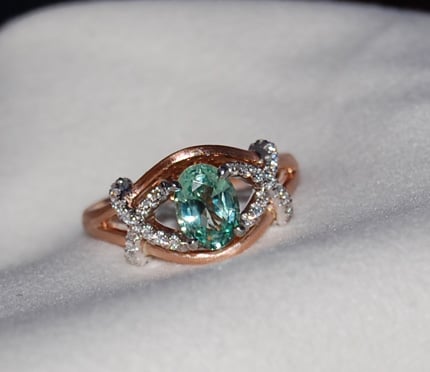Barrett
Ideal_Rock
- Joined
- May 26, 2009
- Messages
- 2,218
Date: 4/5/2010 12:33:44 PM
Author: Kismet
Date: 4/5/2010 12:24:39 PM
Author: LovingDiamonds
Brilliant photo and lovely stone Kismet. Thank you for sharing.
Well the first difference is obvious - you can photograph it and capture the green! The second difference is that yours is far more green than mine. I''d love to know if yours has fluor or not. Would it be too much trouble to ask you to look for me please? I wonder if that''s the difference between the two????
Sure I can check for you when I get home. If it does fluoresce, no guarantees on a picture. I haven''t been able to take a decent picture under black light yet; mine all come out purple or way over exposed or both.
LD's reference: Fluorescence is another property to help us differentiate. Chrysoberyl owns its yellowish color to iron and usually shows no fluorescence. The red fluorescence of alexandrite can be observed using the “crossed filter” method and it has been inferred that in border line cases the presence of a red glow and a faint chromium spectrum absorption spectrum would prove the stone to be alexandrite and not chrysoberyl.
Date: 4/5/2010 12:17:45 PM
Author: Kismet
This is my vanadium chrysoberyl. The picture is mostly accurate; the color is pretty spot on just not as saturated as the picture implies.

Date: 4/5/2010 4:26:23 PM
Author: stepcutgirl
I have nothing to add. Just wanted to tell you I really like it!
Date: 4/5/2010 6:16:50 PM
Author: zeolite
This is because the presence of iron stops the fluorescence.
Rubies often fluorescence because they are colored by chromium and contain very low or no detectable iron. No garnets (that I can readily recall) fluoresce, because they always contain some iron. The principal metal in the almandite garnet formula is iron, and while the main metal in grossular is calcium, and the main metal in pyrope is magnesium, both always contain some iron.
So - chrysoberyl should not fluoresce since (above) it owes its color to iron. LD's vanadium grossular, would probably be classified as an alexandrite, because the strong fluorescense is proof of extremely low or no detectable iron.
Date: 4/5/2010 9:10:34 PM
Author: tourmaline_lover
That is fascinating. Are there any other elements that stop fluorescence besides iron? Perhaps that''s why some chromium bearing stones fluor and others do not. I never knew why some did and some did not. This is a ''light bulb'' moment!
LD,
Sounds like you do have an alexandrite there. I think they find YOU, instead of you finding them now. LOL!!
Zeolite, some grossulars do fluoresce, so does this mean they contain little or no iron?
http://www.faqs.org/patents/app/20090051897
[0036]FIG. 5 is a plot or graph of the wavelength versus intensity for a number of natural and synthetic ruby elements exposed to a red light incident light source. Again, the red LED incident light source peaking at 635 nanometers is shown at line 60. A natural Be treated ruby is shown at line 62, a natural treated ruby from Burma is shown at line 64 and a synthetic flame fusion ruby is shown at line 65. Be treated rubies usually start out as a poor coloured sapphire, often iron quenched, thus explaining the poor red fluorescence shown here.
Date: 4/5/2010 10:18:51 PM
Author: zeolite
Date: 4/5/2010 9:10:34 PM
Author: tourmaline_lover
That is fascinating. Are there any other elements that stop fluorescence besides iron? Perhaps that's why some chromium bearing stones fluor and others do not. I never knew why some did and some did not. This is a 'light bulb' moment!
LD,
Sounds like you do have an alexandrite there. I think they find YOU, instead of you finding them now. LOL!!
Zeolite, some grossulars do fluoresce, so does this mean they contain little or no iron?
No other elements that I am aware of. Here are two links connecting iron with quenching fluorescence:
http://www.minerant.org/gallery1.html
CALCITE, Santa Eulalia, Mexico
… Under daylight the crystals exhibit a dark brown color suggesting the presence of iron- or manganese-ions. It is well-known that the presence of iron in a crystal acts as a fluorescence-killer.
http://www.faqs.org/patents/app/20090051897
[0036]FIG. 5 is a plot or graph of the wavelength versus intensity for a number of natural and synthetic ruby elements exposed to a red light incident light source. Again, the red LED incident light source peaking at 635 nanometers is shown at line 60. A natural Be treated ruby is shown at line 62, a natural treated ruby from Burma is shown at line 64 and a synthetic flame fusion ruby is shown at line 65. Be treated rubies usually start out as a poor coloured sapphire, often iron quenched, thus explaining the poor red fluorescence shown here.
Hmmm, grossular fluoresces? Can you list a link?
I have an obscene amount of garnets. I just tested 63 of my garnets, including 23 grossulars and 9 color change garnets. Not one will fluoresce.
I tested my 3 chrysoberyls; not one would fluoresce.
I tested 10 spinels; 3 would fluoresce. One weak one was a Tanzanian mahenge pink-orange spinel. It fluoresces weakly. My two hyper-intense Burmese flame spinels fluoresce VERY strongly.
I tested 20 sapphires and one ruby. Since blue and purple sapphires are colored by titanium and iron, you don't expect them to fluoresce, you expect the pink ones to do so. All if my pinks fluoresced, some weakly, some very strongly.
Date: 4/5/2010 11:02:33 PM
Author: amethystguy
I have already spoken with LD offsite and she loves and would much rather her thread go this way than anything else..she appreciates the ninfo thats is shared and learned..not only as a benefit to her and to me but everyone who gets to read the info being presented..an educated consumer/collector is a deadly consumer(for the unscupulous vendors)..LOL..no green diamonds here..some great info zeolite and TL..please keep this thrwead running..it''s great for everyone
